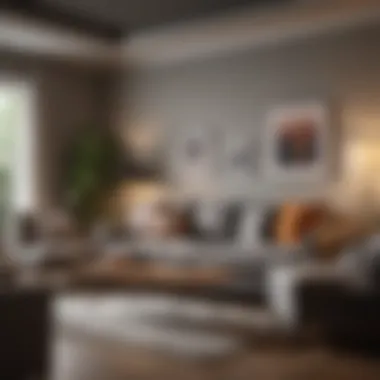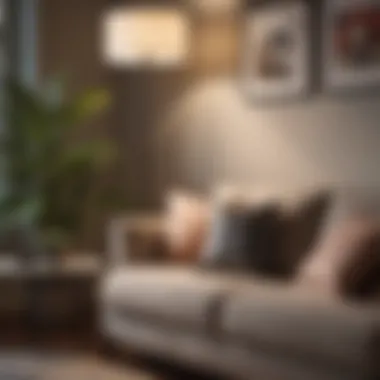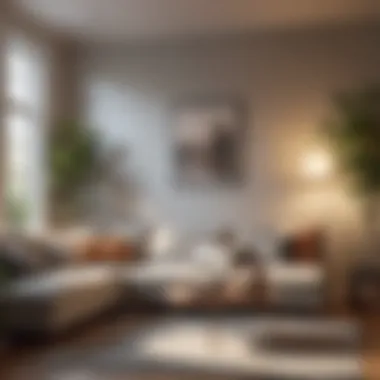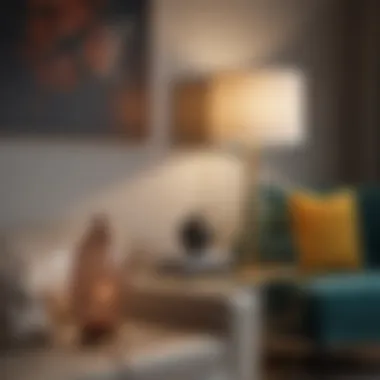Enhancing Spaces: Corner Lamps Behind Couches


Intro
The placement of corner lamps behind couches is an interior design strategy that maximizes both aesthetic appeal and functionality. In contemporary homes, lighting plays a crucial role in defining the atmosphere of a room. Corner lamps not only provide illumination but also serve as sculptural elements, enhancing the overall design theme. This article delves into the practical and aesthetic implications of this strategic approach, aiming to equip homeowners and design enthusiasts with actionable insights.
Design Inspiration
Current Trends in Interior Design
The use of corner lamps behind couches aligns with several current trends in interior design. Minimalism remains at the forefront, where simplicity is key. In this context, lamps fit seamlessly as both functional and decorative elements, complementing a sparse aesthetic without overwhelming the space.
Industrial designs often emphasize darker color palettes and rough textures. Corner lamps with metal finishes, like those from West Elm or CB2, can enhance this look. Mid-century modern styles, popularized by brands like Room & Board, favor angular shapes and warm woods, which also support the placement of lamps in corners behind couches.
Color Schemes and Palette Ideas
Achieving a harmonious visual flow in a room is essential. Corner lamps can help maintain cohesion by tying together various color schemes.
- For a neutral palette, consider lamps in shades of beige, gray, or soft white. These lamps tend to blend and create a calming effect.
- In contrast, a vibrant or eclectic decor style can benefit from bold colors like deep blue or mustard yellow in lamp designs.
Such color choices can enhance the decor theme while ensuring the room feels integrated. Choosing lamps that reflect or complement the couch's upholstery can create a more polished look.
Functional Benefits
Placing lamps behind couches is not merely a stylistic decision; it also offers several functional benefits that enhance the living experience.
Enhanced Lighting
In many interiors, overhead lighting can create harsh shadows or leave dark corners. Lamps positioned strategically behind couches can ensure that the light is softer and more diffused. This effect creates an inviting ambiance.
Spatial Feeling
Couches often dominate a room's layout. When paired with corner lamps, they can visually extend the space, making the area feel larger. Proper positioning encourages movement and prevents the cluttered sensation that can arise in small rooms, particularly if space is limited.
Design Cohesion
Integrating corner lamps into a room's design can improve aesthetic cohesion. The lamps function as decorative elements that can mirror other decor aspects, such as wall art or decorative pillows. This practice enhances the aesthetic unity of the room.
Selecting Suitable Lamp Styles
Choosing the right corner lamp is crucial for achieving the desired effect. Here are some styles to consider:
- Arc Lamps: These provide a sweeping curve that adds dynamism to the space.
- Floor Lamps: Tall options can fill awkward spaces without being bulky.
- Table Lamps: A more compact choice if the couch has side tables or ledges.
When selecting a lamp, consider how the leg heights, color, and overall form harmonize with the existing furniture and decor.
The End
Strategically placing corner lamps behind couches can transform any room into a well-lit and inviting space. This article highlighted the interplay between soft lighting, spatial design, and aesthetic unity, empowering readers to make informed choices in their home decor decisions. By adopting these practices, creating a cohesive and enjoyable living space becomes achievable.
Prolusion to Corner Lamps
The placement of corner lamps behind couches presents both functional and aesthetic benefits within a home. This topic is essential for homeowners and design enthusiasts who seek to enhance their living spaces. Corner lamps not only provide illumination but also contribute to the overall design dynamics of a room. Their strategic position can help define spaces, enhance mood, and elevate the style of furniture.
Choosing the right corner lamp involves understanding the distinct characteristics that make them suitable for this placement. Elements such as height, light intensity, and design should align with the surrounding furniture to create harmony. A well-selected lamp can also maximize the efficiency of a room's lighting. Locale where the light is used often undergoes redesign, making corner lamps a practical choice for adaptability.
Understanding Corner Lamps
Corner lamps are designed to fit snugly into the corners of rooms, utilizing space that might otherwise go underused. Their streamlined design often allows them to blend with existing decor without overwhelming the surroundings. These lamps come in various styles, heights, and materials, making it easy to find an option that suits individual tastes.
When selecting corner lamps, consider the specific purpose they serve. Are they primarily for ambient lighting, or are they meant to highlight a certain area? The ability to adjust light direction can enhance their functionality.
Historical Context of Floor Lamps
The evolution of floor lamps has paralleled changes in design trends and usage in homes. Initially, floor lamps served merely as sources of light in darker spaces. Over time, they transformed into stylistic pieces that characterize a room's design ethos.
In the early 20th century, designers began to understand the potential of lamps beyond mere functionality. Art Deco, mid-century modern, and contemporary styles have since influenced lamp designs, reflecting artistic movements and cultural shifts. Today, floor lamps, including corner options, are not just practical tools; they embody sophisticated design choices that resonate with modern lifestyles.
"In many ways, corner lamps mark the intersection of utility and artistry, changing how we view both light and space."
Understanding this history provides context for modern choices. Knowing where corner lamps fit into design traditions helps appreciate their place in contemporary interiors.
Functional Benefits of Corner Lamps
Lighting Considerations
Ambient Lighting


Ambient lighting is essential for establishing a base layer of illumination in any room. It provides an even distribution of light, which helps to reduce harsh shadows. In the context of corner lamps, this type of lighting is particularly beneficial because it softens the starkness that can arise from overhead lighting. Corner lamps positioned strategically can enhance a cozy atmosphere, making spaces feel inviting. However, while ambient lighting promotes warmth, it may not be sufficient for activities requiring more focused light.
Task Lighting
Task lighting focuses on specific areas to facilitate activities such as reading, working, or hobbies. When corner lamps are used as task lighting, they offer a practical solution without overwhelming the space. These lamps can often be adjusted to direct light where needed, thus improving functionality. The key characteristic of task lighting is its ability to provide light that enhances productivity. The drawback is that if not properly positioned, it may create uneven lighting or added glare.
Accent Lighting
Accent lighting is utilized to highlight specific features within a room, like artwork or architectural details. When corner lamps serve as accent lights, they draw attention to particular elements while enriching the overall aesthetic. The unique feature of accent lighting is its ability to create visual interest and depth in a space. Despite its advantages, overuse can lead to a cluttered look instead of a cohesive atmosphere.
Space Efficiency
Maximizing Floor Space
One of the advantages of corner lamps is their ability to maximize floor space. This is particularly valuable in smaller rooms where every square foot counts. By placing a lamp in the corner, it frees up the central area for movement and other furniture arrangements. The key characteristic here is the efficient use of often neglected corners, transforming them into functional spaces. Admittedly, the placement may require consideration of lamp height and design to ensure it does not dominate the room.
Creating Visual Continuity
Creating visual continuity is crucial for cohesive interior design. Corner lamps provide an opportunity to link various styles and colors within a room, thus generating a harmonious look. This is especially relevant when matching the lamp’s design with existing furniture. A well-placed corner lamp can bridge gaps between different design elements in the space. However, it requires careful selection to avoid mismatches that disrupt the rhythm of the room.
Aesthetic Considerations
The aesthetics of a room greatly affects how it feels and functions. In the context of corner lamps placed behind couches, aesthetics play a critical role. They not only illuminate but also influence the overall style and ambiance of the space. When chosen wisely, these lamps can enhance both form and function in the interior design, creating a harmonious environment.
Design Harmony with Furniture
Scale and Proportion
Scale and proportion are fundamental elements when selecting lamps that fit into a room's existing furniture layout. A lamp that is too large can overwhelm the space, while one that is too small may not provide adequate light or visual interest. The key characteristic of this consideration is balance. Proper scale creates a visual rhythm, enhancing the room’s design.
Placing a corner lamp behind a couch offers an opportunity to achieve that balance. A taller lamp with a slender profile may draw the eye upward, making the area feel more spacious. Conversely, a shorter lamp might work better if the couch is particularly high. This adaptability makes scale and proportion a beneficial consideration for anyone looking to beautify their space.
Style Matching
Style matching involves aligning the aesthetic of the lamp with the existing decor. Whether the room has a contemporary feel or leans more towards vintage charm, the lamp should complement those styles. The pivotal characteristic of this aspect is cohesion. When elements of different styles coexist, they should not clash; rather, they should provide a seamless transition from one piece to another.
For example, a modern lamp with clean lines may contrast poorly in a traditionally styled room. Choosing a lamp that resonates with the existing style brings forth a unified look, enhancing the overall appearance. This aspect allows homeowners to express their personal taste effectively while also ensuring functional lighting.
Enhancing Interior Themes
Modern Designs
Modern design is characterized by simplicity and functional beauty. Choosing corner lamps that adhere to these principles directly contributes to a clean aesthetic. The key characteristic of modern designs is minimalism. They avoid excessive ornamentation and focus on strong lines and subdued colors, which can make a room appear more sophisticated.
Using modern lamps behind couches can instill a contemporary vibe into the room, and because they often employ innovative materials and energy-efficient bulbs, they offer sustainability benefits. However, their sometimes stark appearance may not appeal to everyone.
Traditional Settings
Traditional settings typically incorporate rich colors, patterns, and textures. Corner lamps that showcase intricate details or classic shapes can enhance this warm ambience. The defining characteristic of this approach is detail. Traditional designs often delight in craftsmanship, making each piece stand out in a curated space.
This can introduce a welcoming atmosphere, perfect for hosting gatherings or enjoying quiet evenings. However, ensure that such lamps do not overpower the room's existing charm.
Eco-Friendly Integrations
Integrating eco-friendly lamps can serve both conversation and sustainability. The emphasis on this approach lies in environmental consciousness. Homeowners increasingly seek options that reduce energy consumption and employ sustainable materials. Eco-friendly designs often feature materials like bamboo or recycled metal, which helps to minimize ecological footprints while offering contemporary designs.
This aspect not only supports a sustainable lifestyle but also adds a layer of narrative to the interior design. However, some may find these options limited in style and aesthetic. Furthermore, they may sometimes come at a higher price point, adding to the investment considerations of such purchases.
Selecting the Right Corner Lamp
Choosing the right corner lamp is a crucial part of improving the ambiance of a room. A well-selected lamp serves both functional and aesthetic purposes. It can enhance the lighting in a room while complementing the furniture and decor. Various aspects influence this choice, including height, base design, materials, and finishes. Understanding these elements can lead to an informed decision that meets both practical needs and design preferences.
Important Features to Consider
Height and Reach
Height and reach are significant factors when selecting a corner lamp. An ideal lamp should provide sufficient illumination without overpowering the space. The height of the lamp affects how well it distributes light. Lamps that are too short may not illuminate the intended area, while those that are excessively tall can create harsh shadows.
Many homeowners find that a lamp with an adjustable height or an extended reach offers flexibility and convenience. For example, a lamp with a flexible arm provides the option to direct light where it is needed most.
Key Characteristics:
- Adjustable height creates versatility in lighting.
- Extended reach can target specific areas.
Advantages:
- Versatile lighting options.
- Ability to customize illumination based on activities.


Disadvantages:
- May require careful measurement to find a balance in a room.
Base Design
Base design plays a pivotal role in the overall stability and aesthetics of the corner lamp. A sturdy base ensures the lamp remains upright and safe, especially in homes with children or pets. Different styles, like tripod or pedestal bases, cater to various tastes and interior themes.
Key Characteristics:
- A wide base offers better stability.
- A minimalistic design can create a modern look.
Advantages:
- Enhanced stability prevents tipping.
- A well-designed base can become a focal point in a room.
Disadvantages:
- Bulky bases may consume more floor space.
Material and Finish Choices
Material and finish choices can significantly influence the lamp's overall appearance and integration into the room. These factors also affect durability and ease of maintenance. Homeowners can explore several options, including metal, wood, and fabric, each presenting unique qualities.
Metal Options
Metal options are known for their durability and sleek appearance. They can complement many design styles, from industrial to modern. Metallic finishes can also reflect light, adding to the room's brightness.
Key Characteristics:
- High durability and resistance to wear.
- Sleek and contemporary aesthetic.
Advantages:
- Long-lasting materials.
- Easy to clean and maintain.
Disadvantages:
- Can get hot if left on for extended periods.
Wooden Finishes
Wooden finishes introduce warmth and texture to the space, making them an excellent choice for traditional and rustic designs. A lamp made of wood can create a cozy atmosphere and enhance the color palette of a room. Different wood types offer various grains and hues for personalization.
Key Characteristics:
- Warmth and natural textur.
- Unique grain patterns make each piece different.
Advantages:
- Enhances a cozy atmosphere.
- Easy to blend with other wooden furniture pieces.
Disadvantages:
- May require more cleaning to avoid dust accumulation.
Fabric Shades
Fabric shades add a layer of softness to the lamp's glow, diffusing light and preventing harsh glare. The variety of colors and patterns can harmonize with other elements in the room. Homeowners often prefer fabric shades for their versatility, allowing for changes in atmosphere with minimal effort.
Key Characteristics:
- Softens illumination providing warm ambiance.
- Variety in textures and colors.
Advantages:
- Enhances comfort and invites relaxation.
- Easy to change or replace for refreshed decor.
Disadvantages:
- Prone to stains or damage.
Placement Strategies
Placement strategies for corner lamps hold significant importance in enhancing the ambiance and functionality of living spaces. The position of a lamp behind a couch does not merely serve a purpose in lighting; it also contributes to the overall decor and layout of the room. Proper placement can create an inviting atmosphere, allow for better use of space, and improve the aesthetics of furniture arrangement.
Optimal Positioning Behind a Couch


Positioning a corner lamp behind a couch can greatly enhance the lighting without overwhelming the space. This strategy draws attention naturally to the sitting area without taking up additional floor space. When selecting the exact spot, consider factors such as the natural light from windows and the purpose of the room. The lamp should provide sufficient illumination for reading or socializing while still adding a decorative element. Furthermore, the height of the lamp is crucial. A taller lamp can align well with taller furniture, while shorter models suit lower sofas better.
Creating Balance in Layouts
The balance within a room layout is critical, and corner lamps play a vital role in achieving this. The use of lamps can help harmonize elements within the room. Careful consideration of how the lamp relates to other pieces of furniture creates a more cohesive design.
Symmetry vs. Asymmetry
When discussing symmetry versus asymmetry in room design, it is essential to understand the nature of these approaches. Symmetry creates a sense of order and predictability, often leading to elegance in design. For instance, placing identical corner lamps on either side of a couch can generate visual stability. Conversely, asymmetrical arrangements introduce dynamic variation, providing a modern look. This style often appeals to younger design enthusiasts who prefer a less formal environment. However, achieving effective asymmetry requires a keen eye to ensure that the overall space remains cohesive rather than chaotic.
Complementary Elements
Complementary elements in design focus on how different furnishings work together. A corner lamp can serve as a grounding piece, supporting other elements in the room while enriching the overall design. This strategy encourages the blending of colors, materials, and styles. For example, a wooden lamp may work well with a leather couch but might clash with metal accents elsewhere in the room. The advantage of using complementary elements is that they allow homeowners to express a unique style without overwhelming the space. However, achieving this harmony may involve careful selection and sometimes trial and error.
Case Studies of Effective Usage
The exploration of case studies of effective usage serves as a crucial element of understanding how corner lamps can profoundly influence both small and large spaces. These studies offer practical examples, illuminating the diverse ways homeowners can successfully integrate corner lamps behind couches. With an emphasis on real-life applications, this section enhances the reader's insight into optimizing light and space in their own home environments.
Typically, effective usage highlights several key aspects:
- Lighting Effects: Demonstrating how corner lamps create warm or focused light depending on placement and selection.
- Spatial Solutions: Revealing how specific placements can enlarge the perceived size of a room.
- Aesthetic Improvement: Showing the correlation between lamp choice and overall design symmetry, leading to visual appeal.
This section will analyze both small spaces and large living areas to explore these aspects further.
Small Spaces
In small spaces, the strategic placement of corner lamps can transform corners from neglected areas into functional focal points. For instance, consider a modest living room with limited square footage. A tall, slender floor lamp positioned behind a couch can produce upward light, tricking the eye into perceiving greater height and airiness. It also draws attention away from the walls, adding depth.
Consider the following benefits:
- Enhanced Functionality: A corner lamp can serve as a comfortable reading light without overwhelming the space.
- Visual Flow: When placed correctly, lamps create a seamless transition between the furniture and walls.
- Color Adjustment: The right lamp shade can alter the ambiance, providing a soft glow that enhances any color scheme.
This strategic placement also minimizes clutter while maintaining brightness, essential in tight living conditions. For example, in a studio apartment, a carefully selected lamp can contribute vitality to the space without occupying precious floor area.
Large Living Areas
In contrast, large living areas require a more nuanced approach. Corner lamps can anchor furniture arrangements and establish a coherent design theme. In vast rooms, a single lamp can fade against the backdrop of ample space if not used wisely. Thus, placing these lamps behind couches can restore balance and give the furniture a defined boundary.
Key considerations include:
- Layered Lighting: Utilizing corner lamps in tandem with ceiling fixtures allows for a multi-dimensional lighting experience.
- Focal Points: A strategically positioned lamp can serve as a visual counterpoint, drawing attention to art pieces or architectural features.
- Defining Areas: In open floor plans, corner lamps can help delineate between living, dining, and kitchen areas, strengthening the layout's overall cohesion.
Overall, examining case studies in both small and large spaces underscores the versatility and functionality of corner lamps. The appropriate placement can maximize lighting efficiency and contribute significantly to a room's aesthetic and feel. By understanding these real-life applications, readers can apply similar strategies to their home designs.
Common Mistakes to Avoid
Understanding common mistakes in the placement of corner lamps can significantly enhance both functionality and aesthetics in a room. Many homeowners and design enthusiasts struggle with finding the right balance in their interiors. This segment aims to pinpoint frequent pitfalls so that readers can avoid them. By learning what can go wrong, individuals are better equipped to create harmonious and inviting spaces.
Ignoring Scale
A significant error often made is ignoring scale when placing corner lamps behind couches. Scale relates to the dimensions of the lamp in relation to the size of the couch and the space itself. A lamp that is too small may appear lost, while one that is overly large can dominate the sofa and create imbalance.
- Many people underestimate the importance of height. A low lamp can seem insignificant in a tall room, whereas a very tall lamp can overwhelm a short couch.
- The proportions also matter a lot. A slender couch paired with a bulky, wide lamp can look awkward. Pay attention to how various sizes interact with each other.
When selecting a lamp, measure the height and consider its base width in relation to the couch’s dimensions. This approach helps everyone find a suitable match, fostering cohesion and visual harmony in the room.
Overlooking Cord Management
Another critical aspect often overlooked is cord management. While choosing a stylish lamp, many forget about how unsightly cords can detract from the overall look. A jumble of cords can lead to a cluttered appearance, even in a well-designed space.
Engaging in thoughtful cord management can greatly enhance the aesthetic. Here are some tips to consider:
- Use cord covers: They conceal unsightly wires along walls and furniture, preventing them from littering the floor.
- Strategically hide cords: Position the lamp where cords can run along furniture or walls, out of sight.
- Choose lamps with integrated cord storage: Some lamps come with built-in solutions for cord management, keeping them tidy and organized.
Proper cord management not only improves aesthetics but also ensures safety, reducing tripping hazards in the living area.
By paying attention to scale and managing cords effectively, users can enhance the practical and visual elements of their corner lamp placement. Each mistake avoided contributes to a more orderly, pleasing environment.
Epilogue
Summarizing Key Points
In summary, several key points underscore the value of corner lamps. First, their position behind couches helps to create a warm and inviting atmosphere, ideal for both relaxation and social gatherings. Secondly, they enhance the room's visual dynamics.
- Functional Aspects: The right placement improves ambient lighting, allowing for a well-lit environment without harsh glare.
- Space Utilization: Corner lamps optimize floor space. Instead of cluttering living areas, they utilize often overlooked corners, aiding in a more spacious feel.
- Design Considerations: The integration of lamps can contribute to a cohesive design theme. Various styles, materials, and heights all play a role in maintaining or elevating aesthetic appeal.
Future Trends in Lighting Design
Lighting design is constantly evolving. Understanding future trends is vital for homeowners and design enthusiasts alike. Currently, several trends are gaining traction:
- Smart Lighting Solutions: With technology advancing, smart lamps allow for programmable lighting, accommodating different moods and activities seamlessly.
- Sustainable and Eco-Friendly Materials: Increasing interest in sustainability drives a demand for lamps made from recyclable, environmentally-friendly materials.
- Integrated Lighting Designs: Future designs will see more lamp styles that integrate seamlessly into furniture, creating multifunctional pieces that serve both as decor and practical lighting solutions.
These trends not only reflect changing consumer preferences but also contribute to a more conscious approach to interior design. By focusing on these elements, homeowners can ensure their lighting choices remain relevant and effective in an ever-evolving design landscape.



